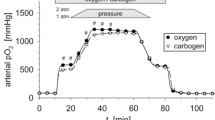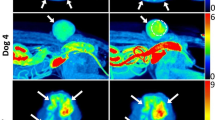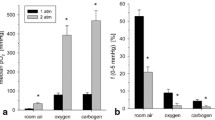Background and Purpose:
The level of hypoxia in primary tumors has been described to influence response to treatment. The aim of the present study was to investigate the impact of pretreatment oxygen level measurements in spontaneous canine tumors on treatment outcome.
Materials and Methods:
Data of pretreatment tumor oxygenation status and local tumor response after primary radiation therapy in a group of spontaneously occurring tumors in dogs (n = 52) was collected. Radiation therapy was given with curative (14–17 × 3–3.5 Gy) or palliative intent (3 × 8 Gy or 4–5 × 6 Gy). Progression-free interval and overall survival were correlated to polarographically measured tumor oxygenation status.
Results:
In the curatively irradiated group, tumors with median pO2 values ≤ 10 mmHg tended to have shorter median progression- free interval compared to better oxygenated tumors (246 vs. 739 days). The same trend could be shown for overall survival (330 vs. 745 days), indicating a cutoff value in this region. In the group treated with lower doses of radiation, the level of oxygen was no longer found to be of prognostic value; however, in this group hemoglobin had a significant impact on outcome.
Conclusion:
In curatively irradiated spontaneous canine tumors, tumor hypoxia was found to be a prognostic indicator, independent of tumor histologies and volume.
Hintergrund und Ziel:
Das Ausmaß der Hypoxie in Primärtumoren beeinflusst das Ansprechen auf eine Therapie. Das Ziel der vorliegenden Studie war, den Zusammenhang zwischen dem prätherapeutischen Sauerstoffstatus und Ansprechen auf die Strahlentherapie bei Hunden zu untersuchen.
Material und Methodik:
Bei Hunden (n = 52) mit spontan auftretenden Tumoren, die entweder einer kurativen (14–17 × 3–3,5 Gy) oder einer palliativen Strahlentherapie (3 × 8 Gy oder 4–5 × 6 Gy) unterzogen wurden, wurde der prätherapeutische Sauerstoffpartialdruck gemessen. Die progressionsfreie Zeit sowie die Gesamtüberlebenszeit nach Therapie wurden mit den polarographisch gemessenen Sauerstoffdaten korreliert (Tabelle 1; Abbildung 1).
Ergebnisse:
In der kurativ bestrahlten Gruppe konnte gezeigt werden, dass Tumoren mit einem Median der pO2-Messwerte von ≤ 10 mmHg eine kürzere progressionsfreie Zeit (246 vs. 739 Tage) und Gesamtüberlebenszeit hatten als besser oxygenierte Tumoren (330 vs. 745 Tage; Abbildung 2). In der palliativ bestrahlten Tiergruppe konnte dieser Effekt nicht gezeigt werden, jedoch wurde ein Einfluss des Hämoglobins auf das Therapieergebnis offensichtlich (Tabellen 2 bis 4).
Schlussfolgerung:
Bei kurativ bestrahlten spontan auftretenden Tumoren des Hundes ist die Hypoxie ein von Histologie und Tumorvolumen unabhängiger prognostischer Faktor.
Similar content being viewed by others

Author information
Authors and Affiliations
Corresponding author
Rights and permissions
About this article
Cite this article
Rohrer Bley, C., Ohlerth, S., Roos, M. et al. Influence of Pretreatment Polarographically Measured Oxygenation Levels in Spontaneous Canine Tumors Treated with Radiation Therapy. Strahlenther Onkol 182, 518–524 (2006). https://doi.org/10.1007/s00066-006-1519-7
Received:
Revised:
Issue Date:
DOI: https://doi.org/10.1007/s00066-006-1519-7



